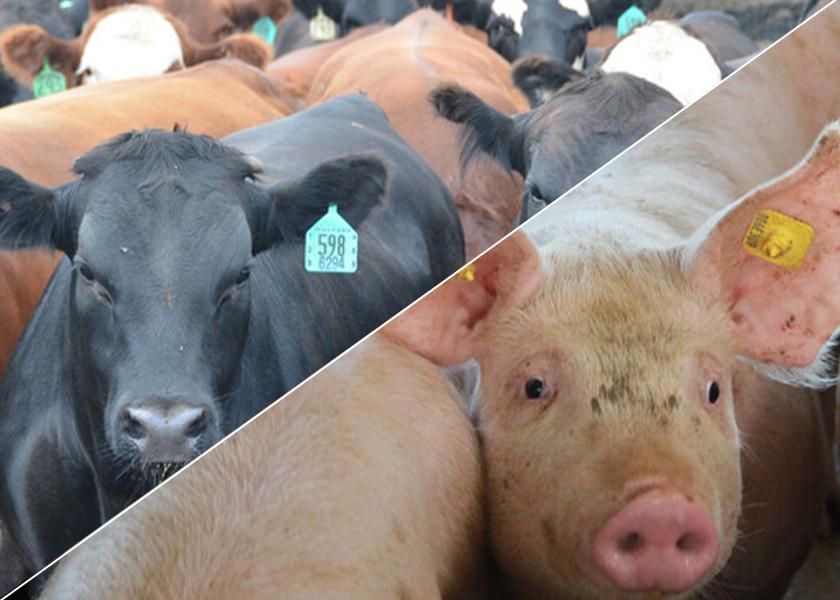Livestock Analysis | July 12, 2022

Hogs
Price action: Nearby hogs rose moderately Tuesday, while the deferred contracts declined. Expiring July futures gained 45 cents to $113.60, while most-active August rose 62.5 cents to $109.00.
Fundamental analysis: Seasonally tight supplies still seem to be supporting the cash hog market, as indicated by Friday’s official hog index surge to $111.77 and by Monday’s preliminary index figure at $112.56, up another 79 cents. July futures expires at noon Friday. If their recent pattern holds, cash hog gains will likely prove minimal or even negative in the days just ahead, but the trend is still pointing upward. Indeed, the $112.56 quote would represent its highest reading since late-June 2021.
The strength being exhibited by the wholesale beef market is seemingly spurring sustained demand for pork as well, as indicated by today’s midsession rise in pork cutout to $116.57, up $1.50 from Monday’s close. In fact, that quote, which obviously will change at the end of this afternoon’s wholesale trading, represents a new 2022 high, although it’s far below last year’s peak at $134.73. Midyear supply tightness is likely boosting the cash and wholesale markets at this point and seems likely to continue doing so in the days ahead. Conversely, slaughter hog numbers will likely begin edging upward in mid-July, then surge by mid-August. That’s a big reason for the discount August futures hold to the July contract, with much larger seasonal supplies, as well as much weaker seasonal demand, coming in fall and winter. Thus, the big discounts built into the deferred contracts.
Technical analysis: Bullish hog traders seem to hold the technical advantage in August hog futures. The bounce from today’s low established initial support at $107.525. Look for much stronger support at yesterday’s low at $106.45, especially since it bounced from the contract’s 40-day moving average in that area. It’s reinforced by the 10- and 20- day moving averages around $106.25. A drop through those levels would have bears targeting the June 30 low at $100.25. Resistance at today’s high of $109.175 seemed stiff, with backing from Monday’s high at $110.425 and last Thursday’s top at $111.75. A close above that point would open the door to a test of the psychological $115.00 level.
What to do: Be prepared to extend feed coverage when market bottoms are in place.
Hedgers: Carry all risk in the cash market for now.
Feed needs: You are hand-to-mouth on corn-for-feed and soybean meal needs.
Cattle
Price action: Live cattle futures advanced broadly Tuesday, with nearby August climbing 52.5 cents to $136.675. Diving grain prices sent feeder prices soaring; August feeder futures rocketed $4.70 higher to close at $179.575.
Fundamental analysis: The cash cattle markets started the week on a firm note, with just a few steers, likely in the northern areas, reportedly changing hands at $145.88. That’s well above last week’s five-area average at $144.35. Reports indicate some feedlot managers in the south are asking around $139.00, but bids are seemingly nonexistent at this point. Still, with market-ready supplies remaining very tight and likely to remain so, we expect the traditional seasonal pattern of weaker cash bids to be limited this summer.
Having wholesale beef prices remain strong also looks supportive. Choice cutout edged up 25 cents Monday and added another 78 cents today in reaching $268.92 at midsession. Select cutout is also rising, which has limited the latest choice-select spread to $24.96, again pointing to tight market-ready cattle supplies. It appears that red meat demand is holding up well in the face of economic uncertainty.
Meanwhile, plunging grain and soy futures spurred aggressive buying in feeder futures. As indicated in the past, the prospect of cheaper feed costs during the coming months encourages feedyard managers to boost their bids for replacement yearlings. Given the downward trends now in place in the grain and soy complexes, this certainly seems very supportive of the feeder outlook. Still, we must point out that futures are trading well above the feeder index (which they cash-settle against). The index leapt from $162.90 last Thursday to Friday’s quote at $168.39, but that’s still over $10 below the August future (which is also the lowest quote on the CME board).
Technical analysis: Bulls still hold the technical advantage in the wake of Monday’s bullish August cattle surge. Look for initial support at yesterday’s close of $136.15, then at today’s low of $135.375. A drop below that level would have bears targeting the contract’s 40-day moving average $133.95, then yesterday’s low at $132.875. Today’s action placed initial resistance at the daily high of $137.00, with considerable backing from the early-June high at $137.95. A breakout above that level would open the door to a test of the contract high at $141.75.
Today’s feeder action marked a bullish breakout on the August futures chart. The high at $179.90 represents tentative initial resistance. A followthrough advance would have bulls targeting the March 29 high at $182.10, then the Feb. 16 contract high at $187.10. Today’s low places initial support at $175.175, with strong backing from the contract’s 10- and 20-day moving averages near $173.55 and $173.28, respectively. A drop below that area would have bears looking to challenge support at the 40-day moving average near $171.24.
What to do: Be prepared to extend feed coverage when market bottoms are in place.
Hedgers: Carry all risk in the cash market for now.
Feed needs: You are hand-to-mouth on corn-for-feed and soybean meal needs.






